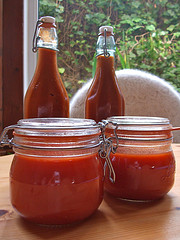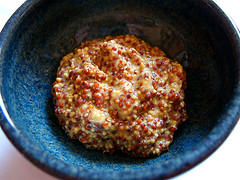Homemade Paleo Condiments
Ketchup
Simple ketchup
This is a simple and quick ketchup recipe for the times when you want to prepare the condiment, but are in a rush or don’t have all the ingredients to prepare the more elaborate ketchup recipe presented below. This one is also very easy to prepare. The typical recipe calls for some sugar, but a sugar-free version tastes just as good and a little bit more tangy. This recipe yields 1.5 cups.
Ingredients
- 1 can (6 ounces) tomato paste;
- 2 tbsp vinegar or lemon juice;
- 1/4 tsp dry mustard;
- 1/3 cup water;
- 1/4 tsp cinnamon;
- 1/4 tsp salt;
- 1 pinch ground cloves;
- 1 pinch ground allspice;
- 1/8 tsp cayenne pepper, optional;
Preparation
- Simply combine all the ingredients in a bowl and whisk well to combine. Refrigerate overnight to let the flavors develop and enjoy!

Rich and deep-flavored ketchup
This is more like a traditional homemade ketchup that we would have seen on kitchen tables a couple of decades ago. It requires a lot of ingredients, but the taste is well worth the trouble. This recipe yields about 2 cups, but don’t be scared to prepare a larger batch, because I’ve got a feeling that it’s going to be popular in your kitchen.Ingredients
- 1 pound fresh plum tomatoes + 1 pound canned plum tomatoes or 2 pounds fresh plum tomatoes, chopped;
- 1 large onion, chopped;
- 1/2 fennel bulb, chopped;
- 1 celery stick, cut in cubes;
 Chopped fresh piece of ginger, about the size of a thumb;
Chopped fresh piece of ginger, about the size of a thumb;- 2 cloves garlic, roughly chopped;
- 1/2 red chili, seeded and chopped finely;
- Large bunch of fresh basil, picked leaves and chopped stalks;
- 1 tbsp coriander seeds;
- 2 cloves garlic;
- 1 tsp freshly ground black pepper;
- Extra virgin olive oil;
- 3/4 cup + 2 tbsp red wine, balsamic or apple cider vinegar;
- Sea salt to taste;
Preparation
- Place the onion, fennel and celery in a large saucepan with some olive oil, the ginger, garlic, chopped chili, basil stalks, coriander seeds and garlic cloves and season with salt and the 1 tsp black pepper.
- Over a low heat, cook for about 12 minutes, until the vegetables have softened, stir occasionally.
- Add 1 1/2 cups water and the tomatoes. Let simmer gently until the liquid is reduced by half.
- Add the basil leaves, pour the sauce in a blender or food processor and process until very smooth.
- Strain the sauce through a sieve into a new or cleaned saucepan and add the vinegar.
- Simmer again until it reaches the desired ketchup consistency. Adjust the seasoning to taste.
- Cool in the refrigerator and enjoy. This ketchup recipe can be bottled in sterilized jars and kept for up to 6 months in a cool dark place.

Mustard
There are many ways to prepare mustard, but the basis is most of the time either mustard powder or mustard seeds. The popular French mustard with the seeds still in is usually called whole-grain mustard, even though it’s not a grain, but a seed. The easiest mustard to prepare is a basic mustard made with mustard powder and water. Other mustards, like Dijon and whole-grain mustard, will take more preparation time as the seeds have to soak and the mustard should sit for a few days for the flavors to develop. The seeds are often soaked in white wine for an even deeper flavor. Prepared mustard will last for about a month and can be kept out of the refrigerator, but refrigeration stops the heat from developing further. A good idea is to refrigerate your mustard when the desired heat is achieved. Homemade mustards won’t be as bright yellow as a store bought mustard, but a bit of added turmeric will do the trick to obtain the same bright color.
Prepared mustard will last for about a month and can be kept out of the refrigerator, but refrigeration stops the heat from developing further. A good idea is to refrigerate your mustard when the desired heat is achieved. Homemade mustards won’t be as bright yellow as a store bought mustard, but a bit of added turmeric will do the trick to obtain the same bright color.Preferably choose glass jars to prepare and store your mustard.
Simple mustard
This is a very basic mustard recipe that can be prepared on demand when you feel like having some mustard. It only takes 1 part water to 1 part mustard powder and you’ll get a nice and hot mustard. Let it stand a for bit and the heat will reduce. You can play around with the seasoning and use different herbs and spices to create different versions. Vinegars or lemon juice will also add a pleasant tanginess.Ingredients
- 1/2 cup mustard powder;
- 1/2 cup water;
- Sea salt to taste;
Preparation
- Combine the mustard powder and water in a bowl and mix well.
- Optionally, add a bit of chopped fresh parsley or basil, lemon or lime zest and a tablespoon or two of your favorite vinegar.
- Let the mustard stand for about 15 minutes before enjoying.

Whole-grain mustard
Feel free to play around with this recipe by adding any of your favorite fresh herb. Sun dried tomatoes and fresh basil are excellent additions.Ingredients
 1/4 cup yellow mustard seeds;
1/4 cup yellow mustard seeds;- 1/4 cup brown mustard seeds;
- 1 cup white wine or water;
- 4 tsp mustard powder;
- 1/4 white wine vinegar;
- 1/2 tsp sea salt;
Preparation
- Soak the mustard seeds in the white wine or water overnight.
- Place the seeds and soaking liquid in a blender or food processor with the mustard powder, vinegar and sea salt. Process to a paste consistency.
- Put in a glass jar, cover and refrigerate for about 4 days before serving.

Lacto-fermented cucumber relish
A relish is usually a preparation of fermented fruits or vegetables used as a condiment. All kinds of relishes can be prepared, but the cucumber relish is probably the most well known. Origination from Sweden, it’s traditionally called Bostongurka, or Boston cucumber. Most store bought relishes use vinegar for pickling, but this traditional recipe uses lacto-fermentation to create the acidic taste and probiotic value of that food. Bubbies is a popular brand available in most health food stores that sales the real unpasteurized cucumber relish.The most popular additional flavors used in cucumber relish are dill, garlic and mustard seeds. The following recipe uses fresh dill. You can use a vegetable starter culture like those available at Cultures for health to ensure success of the lacto-fermentation, but I find that simply using sea salt yields great results.
Ingredients
 4 large cucumbers, chopped finely;
4 large cucumbers, chopped finely;- 2 tbsp fresh dill or 2 tsp dried;
- 2 tbsp sea salt;
Preparation
- In a bowl, mix the chopped cucumbers, dill and sea salt.
- In a quart sized glass jar equipped with a lid, pack the cucumber mixture tightly with a wooden spoon or your fist, making sure to extract the most water out of the mixture. You want the water to cover the mixture for the fermentation process to happen and to prevent mold from forming.
- Add some filtered water if needed.
- Make sure that there is at least 1 inch of room between the liquid and the top of the jar as the mixture will expand during the fermentation time.
- Cover the glass jar tightly with the lid and leave in a warm place for 2 to 5 days. You can taste the relish during the fermentation process to know if it’s ready of not.
- When ready, transfer to the refrigerator and enjoy.

Horseradish
Horseradish is the name of a root vegetable of the brassica family used to prepare a horseradish condiment often simply called horseradish or prepared horseradish. It has a quite pungent and hot taste and goes well with roasted red meat or mixed in some mayonnaise. Today most prepared horseradish is made with vinegar, but the traditionally prepared horseradish is lacto-fermented like sauerkraut. This makes for a very healthy probiotic condiment that will last for months in the refrigerator.
Today most prepared horseradish is made with vinegar, but the traditionally prepared horseradish is lacto-fermented like sauerkraut. This makes for a very healthy probiotic condiment that will last for months in the refrigerator.You might find it difficult to find fresh horseradish roots, but most well-stocked or ethnic grocery stores will have them, especially when in season.
Simple horseradish
This is the simplest of recipes and it’s quick to prepare. While it won’t feature the same deep and fuzzy flavor as the traditionally prepared and fermented horseradish, it’s still great.Ingredients
- 1 cup peeled and minced horseradish root;
- 3/4 cup white wine vinegar;
- 1/4 tsp sea salt;
Preparation
- Process all the ingredients in a blender or food processor to a paste.
- Enjoy right away or store in the refrigerator.

Beet horseradish
This is a nice twist on the basic horseradish and you’ll often see the beet horseradish variation in stores, featuring a bright red color.Ingredients
 3/4 lb horseradish root, minced;
3/4 lb horseradish root, minced;- 1 cup finely chopped beets;
- 3/4 cup apple cider vinegar;
- 1/2 tsp sea salt;
Preparation
- Process all the ingredients in a blender or food processor to a paste.
- Enjoy right away or store in the refrigerator.

Traditionally fermented horseradish
This is the recipe for the real traditional horseradish. This one requires between 3 and 7 days of fermentation, but it’s a nice experiment to try with the little ones and it will give you a wonderful and pungent probiotic condiment. You will also need a vegetable starter culture of some kind for the fermentation process to happen. Most health food stores will carry them, but you can also get a starter online at Cultures for Health. Caldwell and Body Ecology are good brands. These starters contain specific strains of bacteria that are especially suited for vegetable fermentation. You’ll be able to use them for all your vegetable fermentation needs. Fresh whey can also be used as the starter. This recipe yields 1 cup horseradish.Ingredients
- 1 cup peeled and finely chopped horseradish root;
- 1 packet vegetable culture starter;
- 2 tbsp to 1/4 cup water;
- 1 1/2 tsp sea salt;
Preparation
- In a food processor, combine the horseradish root, starter culture, sea salt and pulse to blend the ingredients.
- Add about 3 tbsp water and process again for about three minutes until the preparation takes the consistency of a paste. Add more water if necessary.
- Place the horseradish paste in a small glass jar and add water on top to fill the jar.
- Cover loosely with the lid and let stand in a warm place for between 3 and 7 days.
- When ready, store in the refrigerator and enjoy!

Barbecue sauce
This BBQ sauce will require even more involvement than most of the other condiments because it calls for homemade mustard, ketchup and Worcestershire sauce. I think the best way to tackle it is to prepare BBQ sauce only when you already have those other condiments handy or if you decide to make a batch of all of those condiments all at once. It can become part of your weekly ritual to prepare some of the weekly paleo food on a given day and to prepare some of the condiments at the same time.This sauce has a nice smoky flavor, thanks to the smoked paprika, and will go well with your barbecued meat or simply as a side condiment with beef, pork or chicken. Unlike most barbecue sauces you’ll find, this one doesn’t use any sugar.
Ingredients
 1 onion, minced;
1 onion, minced;- 1 clove garlic, minced;
- 1 can (6 oz) tomato paste;
- 1/2 cup apple cider vinegar;
- 1/2 cup water;
- 1/4 cup homemade ketchup;
- 3 tbsp homemade mustard;
- 1 tbsp Worcestershire sauce;
- 1 pinch ground cloves;
- 1 pinch cinnamon;
- Smoked paprika to taste;
- Hot sauce to taste, optional (check the ingredients and chose a high-quality sauce);
Preparation
- In a large frying pan, with a bit of cooking fat, brown the onion for about 4 minutes.
- Add the garlic and cook for another minute.
- Add all the other ingredients and simmer for 30 minutes.
- Taste the sauce and adjust with more smoked paprika, vinegar or hot sauce to the desired taste.
- Cool and store in the refrigerator.
Comments
Post a Comment